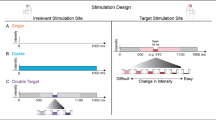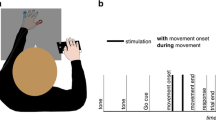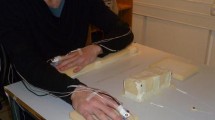Abstract
Several recent studies have provided support for the view that tactile stimuli/events are remapped into an abstract spatial frame of reference beyond the initial somatotopic representation present in the primary somatosensory cortex. Here, we demonstrate for the first time that the extent to which this remapping of tactile stimuli takes place is dependent upon the particular demands imposed by the task that participants have to perform. Participants in the present study responded to either the elevation (up vs. down) or to the anatomical location (finger vs. thumb) of vibrotactile targets presented to one hand, while trying to ignore distractors presented simultaneously to the other hand. The magnitude and direction of the target–distractor congruency effect was measured as participants adopted one of two different postures with each hand (palm-up or palm-down). When the participants used footpedal responses (toe vs. heel; Experiment 1), congruency effects were determined by the relative elevation of the stimuli in external coordinates (same vs. different elevation), regardless of whether the relevant response feature was defined externally or anatomically. Even when participants responded verbally (Experiment 2), the influence of the relative elevation of the stimuli in external space, albeit attenuated, was still observed. However, when the task involved responding with the stimulated finger (four-alternative forced choice; Experiment 3), congruency effects were virtually eliminated. These findings support the view that tactile events can be remapped according to an abstract frame of reference resulting from multisensory integration, but that the frame of reference that is used while performing a particular task may depend to a large extent on the nature of the task demands.








Similar content being viewed by others
References
Andersen RA (1995) Encoding of intention and spatial location in the posterior parietal cortex. Cereb Cortex 5:457–469
Austen EL, Soto-Faraco S, Enns J, Kingstone A (2003) Visual influences on tactile localization depend on limb orientation and response mapping. Abstr Cogn Neurosci Soc Meet F316:225
Austen EL, Soto-Faraco S, Enns J, Kingstone A (2004) Mislocalizations of touch to a fake hand. Cogn Affect Behav Neurosci 4:170–181
Axelrod S, Thompson LW, Cohen LD (1968) Effects of senescence on the temporal resolution of somesthetic stimuli presented to one hand or both. J Gerontol 23:191–195
Azañón E, Soto-Faraco S (2007) Alleviating the ‘crossed-hands’ deficit by seeing uncrossed rubber hands. Exp Brain Res 182:537–548
Azañón E, Soto-Faraco S (2008) Changing frames of reference during the encoding of tactile events. Curr Biol 18(14):1044–1049
Baylis GC, Driver J, Rafal RD (1993) Visual extinction and stimulus repetition. J Cogn Neurosci 15:453–466
Botvinick M, Cohen J (1998) Rubber hands ‘feel’ touch that eyes see. Nature 391:756
Cohen YE, Andersen RA (2000) Reaches to sounds encoded in an eye-centered reference frame. Neuron 3:647–652
Cohen YE, Andersen RA (2004) Multimodal spatial representations in the primate parietal lobe. In: Spence C, Driver J (eds) Crossmodal space and crossmodal attention. Oxford University Press, Oxford, pp 99–121
Cohen JD, Romero RD, Servan-Schreiber D, Farah MJ (1994) Mechanisms of spatial attention: the relation of macrostructure to microstructure in parietal neglect. J Cogn Neurosci 6:377–387
Corcoran DWJ (1977) The phenomena of the disembodied eye or is it a matter of personal geography? Perception 6:247–253
Desimone R, Duncan J (1995) Neural mechanisms of selective attention. Annu Rev Neurosci 18:193–222
di Pellegrino G, Rafal R, Tipper SP (2005) Implicitly evoked actions modulate visual selection: Evidence from parietal extinction. Curr Biol 15:1469–1472
Driver J, Grossenbacher PG (1996) Multimodal spatial constraints on tactile selective attention. In: Inui T, McClelland JL (eds) Attention and performance XVI: information integration in perception and communication . MIT Press, Cambridge, pp 209–235
Duhamel JR, Bremmer F, BenHamed S, Graf W (1997) Spatial invariance of visual receptive fields in parietal cortex neurons. Nature 389:845–848
Eimer M, Driver J (2000) An event-related brain potential study of crossmodal links in spatial attention between vision and touch. Psychophysiology 37:697–705
Eimer M, Cockburn D, Smedley B, Driver J (2001) Cross-modal links in endogenous spatial attention are mediated by common external locations: evidence from event-related brain potentials. Exp Brain Res 139:398–411
Evans PM, Craig JC (1991) Tactile attention and the perception of moving tactile stimuli. Percept Psychophys 49:355–364
Evans PM, Craig JC, Rinker MA (1992) Perceptual processing of adjacent and nonadjacent tactile nontargets. Percept Psychophys 52:571–581
Gallace A, Spence C (2005) Visual capture of apparent limb position influences tactile temporal order judgments. Neurosci Lett 379:63–68
Gallace A, Spence C (2008) The cognitive and neural correlates of “tactile consciousness”: a multisensory perspective. Conscious Cogn 17:370–407
Gallace A, Tan HZ, Spence C (2006a) Numerosity judgments in tactile perception. Perception 35:247–266
Gallace A, Tan HZ, Spence C (2006b) The failure to detect tactile change: a tactile analogue of visual change blindness. Psychon Bull Rev 13:300–303
Gallace A, Tan HZ, Spence C (2007) Multisensory numerosity judgments. Percept Psychophys 69:487–501
Gallace A, Tan HZ, Spence C (2008) The body surface as a communication system: the state of art after 50 years of research. Presence Teleoperators Virtual Environ 16:655–676
Geffen G, Rosa V, Luciano M (2000) Effect of preferred hand and sex on the perception of tactile simultaneity. J Clin Exp Neuropsychol 22:219–231
Gottlieb JP, Kusunoki M, Goldberg ME (1998) The representation of visual salience in monkey parietal cortex. Nature 391:481–484
Graziano MSA, Gross CG (1998) Spatial maps for the control of movement. Curr Opin Neurobiol 8:195–201
Graziano MSA, Gross CG, Taylor CSR, Moore T (2004) A system of multimodal areas in the primate brain. In: Spence C, Driver J (eds) Crossmodal space and crossmodal attention. Oxford University Press, Oxford, pp 51–67
Groh JM, Sparks DL (1996) Saccades to somatosensory targets: 1. Behavioral characteristics. J Neurophysiol 75:412–427
Holmes NP, Spence C (2005) Visual bias of unseen hand position with a mirror: spatial and temporal factors. Exp Brain Res 166:489–497
Holmes NP, Spence C (2006) Beyond the body schema: visual, prosthetic, and technological contributions to bodily perception and awareness. In: Knoblich G, Thornton IM, Grosjean M, Shiffrar M (eds) Human body perception from the inside out. Oxford University Press, Oxford, pp 15–64
Jay MF, Sparks DL (1987) Sensoriomotor integration in the primate superior colliulus. I. Motor convergence. J Neurophysiol 57:22–34
Kanwisher N, Driver J, Machado L (1995) Spatial repetition blindness is modulated by selective attention to color or shape. Cognit Psychol 29:303–337
Kennett S, Spence C, Driver J (2002) Visuo-tactile links in covert exogenous spatial attention remap across changes in unseen hand posture. Percept Psychophys 64:1083–1094
Kitazawa S (2002) Where conscious sensation takes place. Conscious Cogn 11:475–577
Kóbor I, Füredi L, Kovács G, Spence C, Vidnyánszky Z (2006) Back-to-front: Improved tactile discrimination performance in the space you can’t see. Neurosci Lett 400:163–167
Kornblum S, Hasbroucq T, Osman A (1990) Dimensional overlap: cognitive basis for stimulus-response compatibility—a model and taxonomy. Psychol Rev 97:253–270
Làdavas E, Farnè A (2004) Neuropsychological evidence for multimodal representations of space near specific body parts. In: Spence C, Driver J (eds) Crossmodal space and crossmodal attention. Oxford University Press, Oxford, pp 69–98
Lakatos S, Shepard RN (1997) Time-distance relations in shifting attention between locations on one’s body. Percept Psychophys 59:557–566
Lloyd DM, Shore DI, Spence C, Calvert GA (2003) Multisensory representations of arm position in human premotor cortex. Nat Neurosci 6:17–18
Maravita A, Spence C, Sergent C, Driver J (2002) Seeing your own touched hands in a mirror modulates cross-modal interactions. Psychol Sci 13:350–356
Millar S (1994) Understanding and representing space: theory and evidence from studies with blind and sighted children. Oxford University Press, Oxford
Millar S, Al-Attar Z (2003) Spatial reference and scanning with the left and right hand. Perception 32:1499–1511
Millar S, Al Attar Z (2004) External and body-centered frames of reference in spatial memory: evidence from touch. Percept Psychophys 66:51–59
Moscovitch M, Behrmann M (1994) Coding of spatial information in the somatosensory system: evidence from patients with neglect following parietal lobe damage. J Cogn Neurosci 6:151–155
Motter BC (1993) Focal attention produces spatially selective processing in visual cortical areas V1, V2 and V4 in the presence of competing stimuli. J Neurophysiol 70:909–919
Narici L, Modena I, Opsomer RJ, Pizzella V, Romani GL, Torrioli G et al (1991) Neuromagnetic somatosensory homunculus: a non-invasive approach in humans. Neurosci Lett 121:51–54
Natsoulas T, Dubanoski RA (1964) Inferring the locus and orientation of the perceiver from responses to stimulation of the skin. Am J Psychol 77:281–285
Oldfield SR, Phillips JR (1983) The spatial characteristics of tactile form perception. Perception 12:615–626
Paillard J (1999) Divided body schema and body image—a double dissociation in deafferented patient. In: Gantchev GN, Mori S, Massion J (eds) Motor control today and tomorrow. Academic Publishing House, Sofia, pp 197–214
Parsons LM, Shimojo S (1987) Perceived spatial organization of cutaneous patterns on surfaces of the human body in various positions. J Exp Psychol Hum Percept Perform 13:488–504
Pavani F, Spence C, Driver J (2000) Visual capture of touch: out-of-the-body experiences with rubber gloves. Psychol Sci 11:353–359
Penfield W, Rasmussen T (1950) The cerebral cortex of man. Macmillan, New York
Pick HL Jr (1974) Visual coding of nonvisual spatial information. In: MacLeod RB, Pick HL Jr (eds) Perception: essays in honor of James J. Gibson. Cornell University Press, Ithaca, pp 153–165
Polanyi ML (1962) Personal knowledge. Routledge & Kegan Paul, London
Pouget A, Sejnowski TJ (2001) Simulating a lesion in a basis function model of spatial representations: comparison with hemineglect. Psychol Rev 108:653–673
Pouget A, Deneve S, Duhamel J-R (2002) A computational perspective on the neural basis of multisensory spatial representations. Nat Rev Neurosci 3:741–747
Rapp B, Hendel SK (2003) Principles of cross-modal competition: evidence from deficits of attention. Psychon Bull Rev 10:210–219
Roberts RD, Humphreys GW (2006) Spatial and frequency judgments of tactile temporal order. Poster presented at the joint meeting of the Experimental Psychology Society and the Nederlandse Vereniging voor Psychonomie, Birmingham, UK, 10–12 April 2006
Röder B, Spence C, Rösler F (2000) Inhibition of return and oculomotor control in the blind. NeuroReport 11:3043–3045
Röder B, Spence C, Rösler F (2002) Assessing the effect of posture change on tactile inhibition-of-return. Exp Brain Res 143:453–462
Röder B, Rösler F, Spence C (2004) Early vision impairs tactile perception in the blind. Curr Biol 14:121–124
Schicke T, Röder B (2006) Spatial remapping of touch: confusion of perceived stimulus order across hand and foot. Proc Natl Acad Sci USA 103:11808–11813
Shore DI, Spry E, Spence C (2002) Confusing the mind by crossing the hands. Brain Res Cogn Brain Res 14:153–163
Shore DI, Gray K, Spry E, Spence C (2005) Spatial modulation of tactile temporal-order judgments. Perception 34:1251–1262
Shore DI, Gallace A, Mimnagh K, Spence C (2006). Assessing the frames of references involved in the crossed hands temporal order judgments deficit: the role of response demands. Paper presented at 7th Annual Meeting of the International Multisensory Research Forum, University of Dublin, Trinity College, Dublin, Ireland. Available at http://www.science.mcmaster.ca/~IMRF/2006/viewabstract.php?id=186
Soto-Faraco S, Ronald A, Spence C (2004) Tactile selective attention and body posture: assessing the contribution of vision and proprioception. Percept Psychophys 66:1077–1094
Spearman C (1907) An ‘economic’ theory of spatial perception. Mind 16:181–196
Spence C (2002) Multimodal attention and tactile information-processing. Behav Brain Res 135:57–64
Spence C, McDonald J (2004) The crossmodal consequences of the exogenous spatial orienting of attention. In: Calvert GA, Spence C, Stein BE (eds) The handbook of multisensory processing. MIT Press, Cambridge, pp 3–25
Spence C, Walton M (2005) On the inability to ignore touch when responding to vision in the crossmodal congruency task. Acta Psychol 118:47–70
Spence C, Pavani F, Driver J (2000) Crossmodal links between vision and touch in covert endogenous spatial attention. J Exp Psychol Hum Percept Perform 26:1298–1319
Spence C, Kingstone A, Shore DI, Gazzaniga MS (2001a) Representation of visuotactile space in the split brain. Psychol Sci 12:90–93
Spence C, Shore DI, Gazzaniga MS, Soto-Faraco S, Kingstone A (2001c) Failure to remap visuotactile space across the midline in the split-brain. Can J Exp Psychol 55:135–142
Spence C, Baddeley R, Zampini M, James R, Shore DI (2003) Crossmodal temporal order judgments: when two locations are better than one. Percept Psychophys 65:318–328
Spence C, Pavani F, Driver J (2004a) Spatial constraints on visual-tactile crossmodal distractor congruency effects. Cogn Affect Behav Neurosci 4:148–169
Spence C, Pavani F, Maravita A, Holmes N (2004b) Multisensory contributions to the 3-D representation of visuotactile peripersonal space in humans: evidence from the crossmodal congruency task. J Physiol (Paris) 98:171–189
Yamamoto S, Kitazawa S (2001) Reversal of subjective temporal order due to arm crossing. Nat Neurosci 4:759–765
Zampini M, Harris C, Spence C (2005) The effect of posture change on tactile perception: impaired direction discrimination performance with interleaved fingers. Exp Brain Res 166:498–508
Acknowlegments
This research was supported by grants from the Oxford McDonnell Pew Center for Cognitive Neuroscience to SS-F and CS, and grants SEJ 2007-64103/PSIC and CDS00012 (Ministerio de Educación y Ciencia) to SS-F.
Author information
Authors and Affiliations
Corresponding author
Rights and permissions
About this article
Cite this article
Gallace, A., Soto-Faraco, S., Dalton, P. et al. Response requirements modulate tactile spatial congruency effects. Exp Brain Res 191, 171–186 (2008). https://doi.org/10.1007/s00221-008-1510-x
Received:
Accepted:
Published:
Issue Date:
DOI: https://doi.org/10.1007/s00221-008-1510-x




